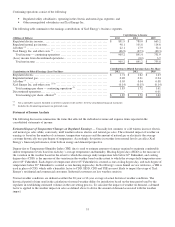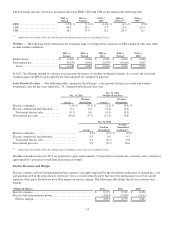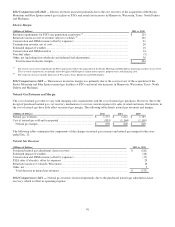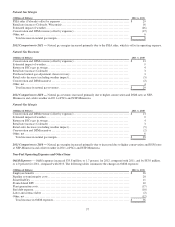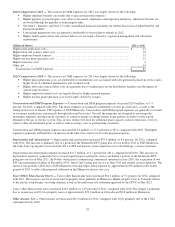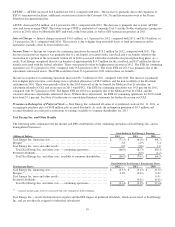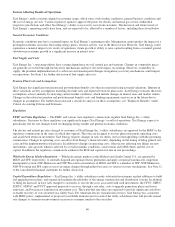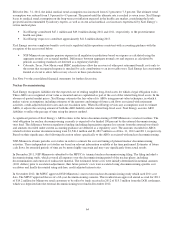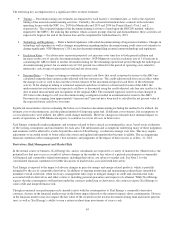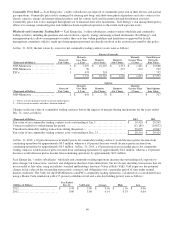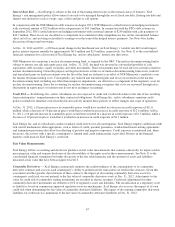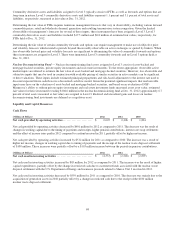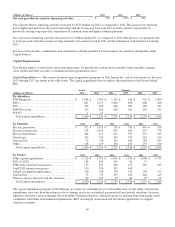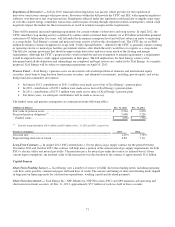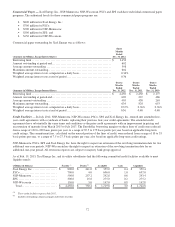Xcel Energy 2012 Annual Report Download - page 73
Download and view the complete annual report
Please find page 73 of the 2012 Xcel Energy annual report below. You can navigate through the pages in the report by either clicking on the pages listed below, or by using the keyword search tool below to find specific information within the annual report.
63
Employee Benefits
Xcel Energy’s pension costs are based on an actuarial calculation that includes a number of key assumptions, most notably the
annual return level that pension and postretirement health care investment assets will earn in the future and the interest rate used
to discount future pension benefit payments to a present value obligation. In addition, the pension cost calculation uses an asset-
smoothing methodology to reduce the volatility of varying investment performance over time. See Note 9 to the consolidated
financial statements for further discussion on the rate of return and discount rate used in the calculation of pension costs and
obligations.
Pension costs are expected to increase in 2013 and then gradually decline in the following few years while funding requirements
are expected to be flat in 2013 and decline in the following years. While investment returns exceeded the assumed levels from
2009 through 2012, investment returns in 2008 were significantly below the assumed levels. The pension cost calculation uses a
market-related valuation of pension assets. Xcel Energy uses a calculated value method to determine the market-related value of
the plan assets. The market-related value is determined by adjusting the fair market value of assets at the beginning of the year to
reflect the investment gains and losses (the difference between the actual investment return and the expected investment return on
the market-related value) during each of the previous five years at the rate of 20 percent per year. As these differences between
the actual investment returns and the expected investment returns are incorporated into the market-related value, the differences
are recognized in pension cost over the expected average remaining years of service for active employees.
Based on current assumptions and the recognition of past investment gains and losses, Xcel Energy currently projects the pension
costs recognized for financial reporting purposes will increase from an expense of $127.1 million in 2012 and $81.0 million in
2011 to an expense of $158.5 million in 2013 and $132.9 million in 2014. The expected increase in the 2013 expense is due
primarily to the continued phase in of unrecognized plan losses primarily resulting from the market decline in 2008.
At Dec. 31, 2012, Xcel Energy set the rate of return used to measure pension costs at 6.88 percent, which is a 22 basis point
decrease from Dec. 31, 2011. The rate of return used to measure postretirement health care costs of 7.11 percent at Dec. 31, 2012
is a 36 basis point increase from Dec. 31, 2011.
Xcel Energy set the discount rates used to value the Dec. 31, 2012 pension and postretirement health care obligations at 4.00
percent and 4.10 percent, which represent a 100 basis point and 90 basis point decrease from Dec. 31, 2011, respectively. Xcel
Energy uses a bond matching study as its primary basis for determining the discount rate used to value pension and postretirement
health care obligations. The bond matching study utilizes a portfolio of high grade (Aa or higher) bonds that matches the expected
cash flows of Xcel Energy’s benefit plans in amount and duration. The effective yield on this cash flow matched bond portfolio
determines the discount rate for the individual plans. The bond matching study is validated for reasonableness against the
Citigroup Pension Liability Discount Curve and the Citigroup Above Median Curve. At Dec. 31, 2012, these reference points
supported the selected rate. In addition to these reference points, Xcel Energy also reviews general actuarial survey data to assess
the reasonableness of the discount rate selected.
The Pension Protection Act changed the minimum funding requirements for defined benefit pension plans beginning in 2008. The
following are the pension funding contributions, both voluntary and required, made by Xcel Energy for 2011 through 2013:
• In January 2013, contributions of $191.5 million were made across four of Xcel Energy’s pension plans;
• In 2012, contributions of $198.1 million were made across four of Xcel Energy’s pension plans;
• In 2011, contributions of $137.3 million were made across three of Xcel Energy’s pension plans.
For future years, we anticipate contributions will be made as necessary. These contributions are summarized in Note 9 to the
consolidated financial statements. Future year amounts are estimates and may change based on actual market performance,
changes in interest rates and any changes in governmental regulations. Therefore, additional contributions could be required in the
future.
If Xcel Energy were to use alternative assumptions at Dec. 31, 2012, a one-percent change would result in the following impact
on 2013 pension expense:
Pension Costs
(Millions of Dollars)
+1%
-1%
Rate of return .....................................................
$
(29.2)
$
29.8
Discount rate ......................................................
(14.1)
17.6


